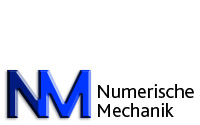DGF-Projekt DI 2306/1
Multi-field modelling and simulation of fibre reinforced polymers
The overall goal of this project is to develop a numerical framework for the simulation of thermomechanical damage and fracture in fibre reinforced polymers under large deformations and displacements. This will help us to predict and understand transient fracture mechanisms as they arise in high-velocity and high-energy impact situations. To this end, several novel and sophisticated numerical methods have to be developed and combined. A phase-field fracture formulation taking into account the anisotropic material behaviour as well as local damage and thermal effects has to be introduced for a realistic prediction of complex three-dimensional fracture patterns. Higher-order phase-field formulations increase the accuracy of the evaluation of the fracture energy but necessitates spatial discretization schemes which fulfil the required continuity conditions. In this context, the concept of isogeometric analysis is able to provide sufficient continuous approximations and has to be considered along with a hierarchical refinement scheme to resolve local features. Advanced mixed variational principles satisfying the polyconvexity condition in the sense of Ball have to be developed for a stable and robust numerical framework. This promising approaches enable great flexibility and clarity for the development of new multi-field formulations, since the constitutive laws can be solved as separate field.

Mortar based contact formulations have shown to be superior against classical collocation type methods and thus they have to be considered for the three-dimensional multi-physical contact interface. Eventually, stable and second order accurate implicit time integration schemes have to be developed. In this context, structure-preserving integrators allow for comparatively large time steps, raising the efficiency and robustness of the simulation of the given problem at hand dramatically. We will combine all different approaches in a unified numerical framework and conduct several static as well as transient benchmark tests for verification purposes and apply this framework finally to realistic industrial applications.
Group: Dr.-Ing. Maik Dittmann, Prof. Dr.-Ing. Christian Hesch
